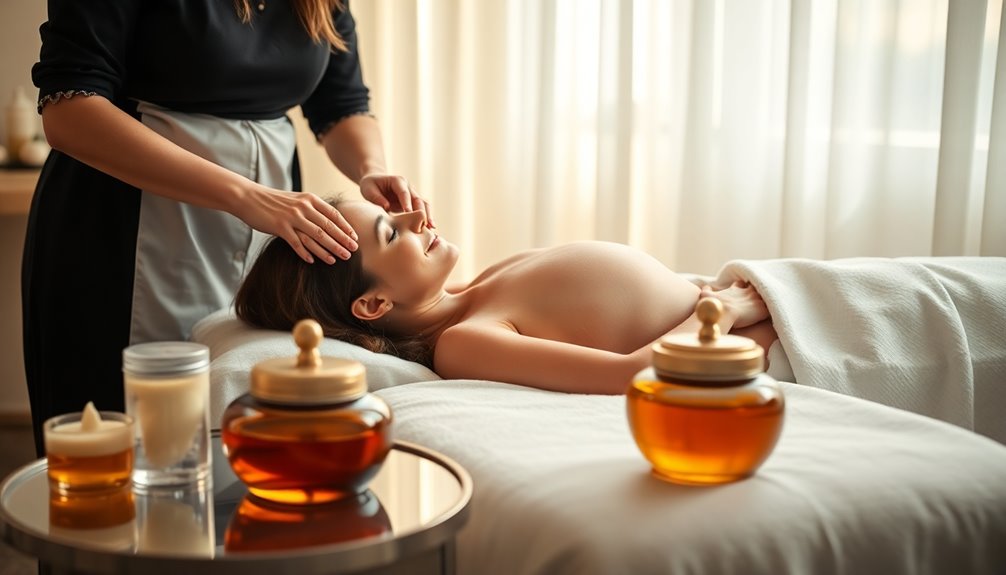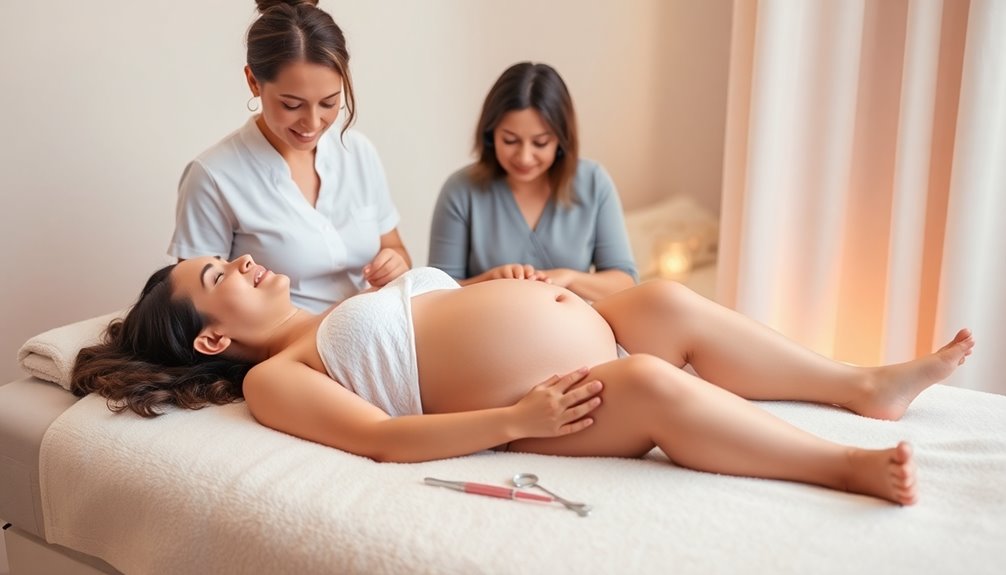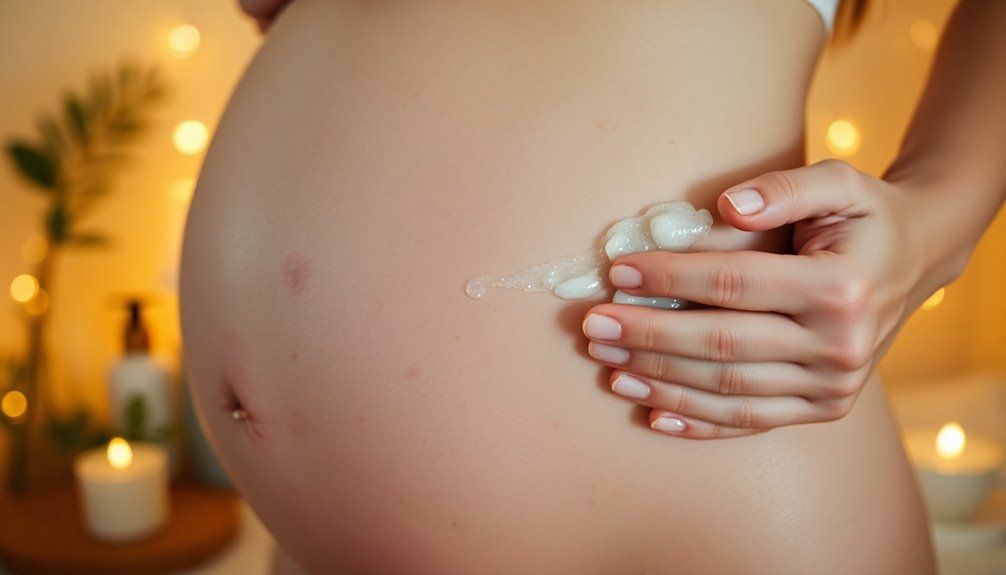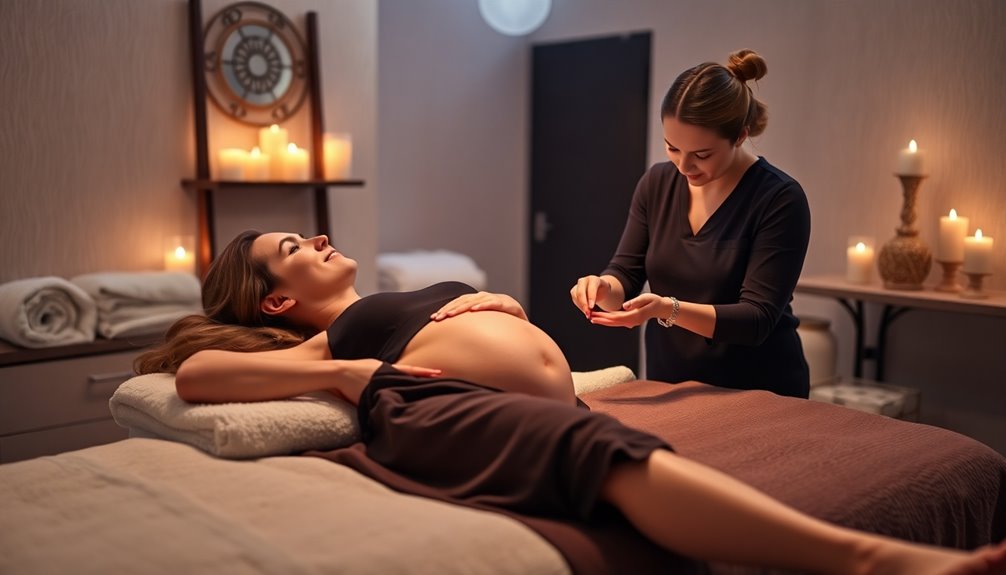Waxing during pregnancy can be safe and effective if you take the right precautions. It's vital to choose an experienced esthetician who understands your unique needs. Hormonal changes may increase skin sensitivity, so communicate openly about your comfort levels. While professional waxing is recommended, gentle alternatives exist too. Post-waxing care is important to manage any irritation. Curious about more tips and tricks for a smooth experience? There's plenty more to explore!
Key Takeaways
- Professional waxing is generally safe during pregnancy when performed by experienced estheticians who follow strict hygiene practices.
- Hormonal changes can increase skin sensitivity and pain, making communication with your esthetician crucial for comfort.
- Consider gentle hair removal alternatives like tweezing or sugaring, as they may be less irritating during pregnancy.
- Proper post-waxing care, including using pregnancy-safe moisturizers and avoiding hot showers, is essential for soothing the skin.
- Always monitor for unusual reactions post-waxing, and consult a healthcare provider if you experience prolonged redness or swelling.
Understanding the Safety of Waxing During Pregnancy

When considering whether waxing is safe during pregnancy, it's important to know that it generally is, but there are a few precautions to keep in mind.
Hormonal changes can lead to increased skin sensitivity, making the process potentially more painful. To guarantee a safe experience, seek an experienced esthetician who follows strict hygiene practices, like not reusing wax or strips between clients. Additionally, using essential oils known for their soothing properties may help ease any discomfort during the waxing process. It is also advisable to ensure that your esthetician is aware of your pregnancy status, as this will help them provide tailored care specific to your needs. Glycolic acid can also be beneficial in maintaining skin health, as it aids in exfoliation and reducing sensitivity.
Before your full waxing session, consider conducting a patch test on a small area of skin to gauge your comfort level. Always communicate openly with your esthetician about your pregnancy, as this helps tailor the experience to your individual needs and minimizes risks associated with unwanted hair removal during this sensitive time. Additionally, maintaining proper skin hydration can help reduce sensitivity and discomfort during the waxing process.
Hormonal Changes and Increased Skin Sensitivity

Hormonal changes during pregnancy can considerably affect your skin's sensitivity and hair growth. You might notice unwanted hair becoming thicker and regrowing faster in various areas. This increase in hair can be frustrating, but it's the heightened blood flow that often leads to increased skin sensitivity, making waxing during pregnancy potentially more painful than usual. Additionally, the emotional stress from narcissistic relationships may further exacerbate your experience during this time. Understanding the impact of emotional abuse can help you navigate these feelings more effectively.
Pregnant women may also experience skin changes like melasma, which can complicate waxing sensitive areas. With this added sensitivity, there's a higher chance of skin irritation and adverse reactions during and after waxing. It's essential to communicate your condition to estheticians, as they can provide appropriate care and make necessary adjustments to guarantee a safer and more comfortable waxing experience. Additionally, high-quality equipment can make a significant difference in ensuring the overall comfort during sensitive procedures like waxing. Moreover, it is crucial to consider the RMD rules for tax-efficient planning, especially if you're planning for financial stability during and after your pregnancy.
Professional Waxing vs. DIY Hair Removal

Choosing between professional waxing and DIY hair removal can feel overwhelming, especially during pregnancy.
Both options have their pros and cons, so consider the following:
- Professional waxing guarantees high hygiene standards with licensed estheticians.
- DIY hair removal methods, like home waxing kits, offer convenience but require careful hygiene. Emotional detachment can develop after 20 years of marriage, which may lead to neglect in self-care practices.
- Personalized recommendations from estheticians can lead to safer techniques tailored for your sensitive skin.
- Professional products, such as those from Tress Wellness, can soothe skin during waxing, a benefit often lacking in DIY kits.
While DIY options are generally safe, they may not provide the same long-lasting results as professional waxing, which removes hair from the root and leaves you with smooth skin for weeks. Additionally, it's important to be mindful of personalized recommendations that can address any unique skin sensitivities you may experience during pregnancy.
Recommended Hair Removal Methods for Expecting Mothers

When it comes to hair removal during pregnancy, you have several safe options to contemplate.
Professional waxing can be a great choice, but gentle alternatives like shaving or tweezing might work better for you as your sensitivity increases.
It's important to weigh the benefits of professional services against DIY methods to find what suits you best.
Safe Waxing Practices
While waxing during pregnancy can be safe, it's important to follow proper practices to guarantee your comfort and safety. Here are some safe waxing practices to keep in mind:
- Choose an experienced esthetician who prioritizes hygiene.
- Communicate your condition clearly to your esthetician.
- Avoid waxing sensitive areas with open cuts, rashes, or varicose veins.
- Remember that hair should be at least one-fourth to three-fourths of an inch long for best results.
With increased skin sensitivity during pregnancy, pain levels may heighten, so pre- and post-waxing care is essential to minimize irritation.
Gentle Alternatives Available
If you're looking for gentle hair removal methods during pregnancy, several safe alternatives can ease your concerns.
Tweezing and threading are excellent options for small areas like your eyebrows and upper lip, as they require no chemicals and minimize discomfort.
For larger areas, shaving is practical, but remember to use clean tools and proper techniques to avoid irritation.
Sugaring offers a gentler alternative to traditional waxing, using a natural paste suitable for sensitive skin.
While hair removal creams can be used, it's essential to test them on a small area first due to uncertain safety during pregnancy.
You should also postpone laser hair removal and electrolysis, as their safety during pregnancy isn't well established.
Professional vs. DIY Options
Choosing between professional and DIY hair removal options during pregnancy can be challenging, but understanding your preferences and needs can help simplify the decision. Here are some key points to reflect on:
- Professional waxing is ideal for larger areas, like the bikini line, ensuring proper hygiene and comfort from licensed estheticians.
- DIY waxing can work well for expectant mothers when using high-quality kits designed for sensitive skin; just remember to do a patch test first.
- Shaving is often the safest method since it involves no chemicals and minimizes irritation.
- Tweezing and threading are excellent for smaller areas like eyebrows, offering precision without the discomfort of waxing.
Ultimately, weigh your options based on your skin sensitivity and comfort level.
Tips for a Comfortable Waxing Experience

To make your waxing experience as comfortable as possible, start by communicating openly with your esthetician about your pregnancy.
Preparing your skin properly and managing pain effectively can also help reduce discomfort during the process.
Keep these tips in mind for a smoother session.
Communicate With Esthetician
When it comes to waxing during pregnancy, clear communication with your esthetician is essential for a comfortable experience.
To guarantee your waxing session goes smoothly, consider these tips:
- Inform your esthetician about your pregnancy to accommodate any increased skin sensitivity.
- Discuss your previous waxing experiences to help them understand your pain tolerance and preferences.
- Ask about the products they use, ensuring they're pregnancy-safe and suitable for sensitive skin.
- Communicate any discomfort during the process, allowing them to adjust their technique or take breaks as needed.
Prepare Skin Properly
Preparing your skin properly can greatly enhance your waxing experience during pregnancy. Start by confirming the hair is one-fourth to three-fourths of an inch long for best results and minimal discomfort.
Clean and dry the area thoroughly to reduce infection risks and help the wax adhere better. Before applying, test the melted wax temperature on your wrist to avoid burns.
Consider using pre-waxing products that soothe your sensitive skin, making the process more comfortable. Avoid waxing on sunburned skin or areas affected by melasma, as this can lead to further irritation.
Manage Pain Effectively
Managing pain effectively during waxing is essential for a comfortable experience, especially during pregnancy. Increased sensitivity can heighten discomfort, so it's vital to communicate openly with your esthetician about your comfort levels.
Here are some tips to help you manage pain:
- Take two Tylenol about an hour before your appointment (consult your doctor first).
- Conduct a patch test on a small skin area to assess your pain tolerance and skin reaction.
- Choose gentle waxing products with soothing ingredients to minimize irritation.
- Wear loose clothing after waxing to reduce post-waxing irritation and enhance recovery.
Managing Pain and Skin Irritation Post-Waxing

Although waxing can leave your skin feeling smooth, it may also lead to increased irritation during pregnancy due to heightened sensitivity.
To manage pain and skin irritation post-waxing, apply a pregnancy-safe moisturizer the day after the procedure. Wearing loose clothing can help minimize irritation and allow your skin to breathe, reducing discomfort.
If you experience any pain, try using cold packs on the waxed area for immediate relief. Avoid hot showers, baths, or strenuous exercise for at least 24 hours, as these can exacerbate skin irritation.
Keep an eye out for unusual reactions, such as prolonged redness or swelling. If you notice any adverse effects, don't hesitate to consult your healthcare provider for guidance.
Tress Wellness Products for Safe Hair Removal During Pregnancy

For a safe and comfortable hair removal experience during pregnancy, Tress Wellness products are designed with your needs in mind.
These specialized waxing products guarantee that you can enjoy waxing during pregnancy without compromising your safety or comfort.
- Hard Wax beads with soothing ingredients like beeswax and jojoba oil protect sensitive skin.
- Bikini Hard Wax minimizes hair breakage and ingrown hairs, perfect for your bikini area.
- Pre and post-waxing sprays enhance your waxing experience while maintaining skin health.
- Wax warmers provide precise temperature control, preventing burns and guaranteeing safe usage.
With Tress Wellness, you can confidently handle hair removal, knowing you're prioritizing both comfort and safety during this special time.
Frequently Asked Questions
Do I Need to Tell My Waxer I'm Pregnant?
Yes, you should definitely tell your waxer you're pregnant.
Informing them allows them to tailor the waxing process to your needs, considering increased skin sensitivity and pain tolerance during pregnancy. They can use gentler techniques and products, guaranteeing a more comfortable experience.
Plus, your waxer may have specific protocols for pregnant clients, so sharing this information helps guarantee the best safety and care for you and your skin.
Don't hesitate to communicate!
Does Waxing Affect Early Pregnancy?
Does waxing affect early pregnancy? You might think it's a hair-raising dilemma, but it's generally safe if you're careful.
Hormonal changes can make your skin more sensitive, so you might feel more discomfort than usual. Plus, those pesky hormones can cause your hair to grow faster, making regular waxing tempting.
Just remember to consult your healthcare provider first, and steer clear of any rashes or cuts to keep your skin happy and healthy!
How Late in Pregnancy Can You Get a Brazilian Wax?
You can typically get a Brazilian wax safely until about a week before your due date.
However, it's best to schedule it before the 36-week mark, as your skin becomes more sensitive and the process can be uncomfortable later in pregnancy.
If you're considering waxing close to delivery, consult your healthcare provider for personalized advice and verify you choose an experienced esthetician to minimize any risks or discomfort.
Communication during the procedure is key.
Is Waxing Safe During the 9th Month of Pregnancy?
You might feel like a walrus in the ninth month, but waxing can be safe. Your skin's more sensitive now, so it could be a bit uncomfortable.
It's best to skip waxing the lower abdomen and pubic area as you near your due date to reduce infection risks.
Always consult a licensed esthetician who knows you're pregnant, and guarantee the facility maintains cleanliness.
You'll want a smooth experience, not a sticky one!
Conclusion
As you navigate the ups and downs of pregnancy, the question lingers: is waxing safe for you? With hormonal changes and heightened skin sensitivity, the stakes feel high. Yet, armed with the right knowledge and tips, you can make informed choices. Whether you opt for professional services or a gentle DIY approach, remember—your comfort matters. So take a deep breath, and embrace this journey with confidence, knowing you can find a hair removal method that suits your needs.









